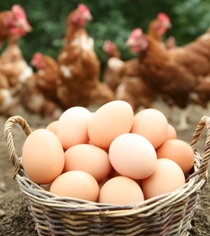Organic Eggs: Breed and feed important for taste

Organic egg production not only means a better life for the hen; choosing the right breeds and the right feed can provide consumers with a better sensory experience, according to Research from Denmark’s Aarhus University.
When you are standing in the supermarket trying to decide which eggs to put in your grocery cart, you may be aware that organic egg production ensures the hen a life with outdoor access in contrast to battery cage egg production where hens are kept indoors all day.
But what about the taste experience? Does it make any difference whether the eggs are conventional or organic? Yes, apparently it does, according to studies at the Faculty of Agricultural Sciences, Aarhus University. In a research project aimed at investigating various production strategies for organic eggs with a high and distinctive quality, the scientists found that organic production was ahead of the game if the hens were fed right and certain hen lines were used.
Senior scientist, Marianne Hammershøj, from the Department of Food Science at the Faculty of Agricultural Sciences explained: “We investigated a series of possibilities for attaining a high and distinctive quality in organic eggs through feeding and by choosing certain breeding lines. With regard to the feed we emphasised using roughage and feed that contained substances that we expected would affect egg taste and appearance.”
The hens were fed different kinds of roughage, including carrots, curly kale, herbs, maize silage and alfalfa silage, and they were fed three different kinds of feed that included, among other things, various levels of carotenoids.
Apart from using various feeding strategies the scientists also chose to use two very different hen lines. One was a modern, specialised egg layer, which has found application in organic egg production, while the other line was a traditional dual-purpose hen that could deliver both eggs and meat.
Egg quality was measured with regard to carotenoid content, appearance, taste, shell strength and albumen quality.
Dr Hammershøj said: “We found that there were marked differences in egg quality between the two types of hens. Eggs from the old-fashioned hen had a better yolk colour and albumen texture. However, the taste and the shell quality were poorer compared to the modern egg layer.”
“Particularly the roughage had an influence on egg quality. Alfalfa silage and curly kale resulted in egg yolks that were darker and with a more intense red and yellow colour. Especially feeding with kale gave eggs a better taste score compared to feeding maize silage,” added Dr Hammershøj.
The studies were part of a larger project, ‘Quality and integrity of organic eggs, chicken meat and pork’ (QEMP) that involved developing new strategies for producing organic eggs and organic chicken meat and pork. The production should result in new products with a high quality distinct from conventional products and which satisfy consumer demands and tastes.
The project is supported by funds from the International Centre for Research in Organic Food Systems (ICROFS).
Join 31,000+ subscribers
Subscribe to our newsletter to stay updated about all the need-to-know content in the poultry sector, three times a week. Beheer
Beheer








 WP Admin
WP Admin  Bewerk bericht
Bewerk bericht